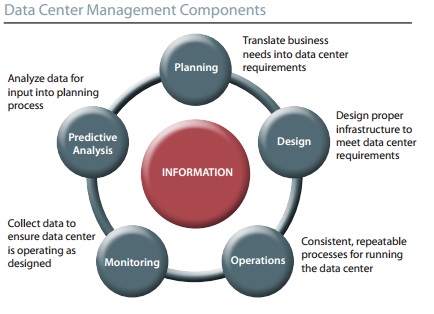 There are a number of benefits in implementing a Data Center Infrastructure System (DCIM) solution. To illustrate this point, consider the primary components of data center management.
There are a number of benefits in implementing a Data Center Infrastructure System (DCIM) solution. To illustrate this point, consider the primary components of data center management.
In the Design phase, DCIM provides key information in designing the proper infrastructure. Power, cooling and network data at the rack level help to determine the optimum placement of new servers. Without this information, data center managers have to rely on guesswork to make key decisions on how much equipment can be placed into a rack. Too little equipment strands valuable data center resources (space, power and cooling). Too much equipment increases the risk of shutdown due to exceeding the available resources.
In the Operations phase, DCIM can help to enforce standard processes for operating the data center. These consistent, repeatable processes reduce operator errors which can account for as much as 80% of system outages.
In the Monitoring phase, DCIM provides operational data, including environmental data (temperature, umidity, air flow), power data (at the device, rack, zone and data center level), and cooling data. In addition, DCIM may also provide IT data such as server resources (CPU, memory, disk, network). This data can be used to alert management when thresholds are exceeded, reducing the mean time to repair and increasing availability.
In the Predictive Analysis phase, DCIM analyzes the key performance indicators from the monitoring phase as key input into the planning phase. Capacity planning decisions are made based during this phase. Tracking the usage of key resources over time, for example, can provide valuable input to the decision on when to purchase new power or cooling equipment.
In the Planning phase, DCIM can be used to analyze “what if” scenarios such as server refreshes, impact of virtualization, and equipment moves, adds and changes. If you could summarize DCIM in one word, it would be information. Every facet of data center management revolves around having complete and accurate information.
DCIM provides the following benefits:
- Access to accurate, actionable data about the current state and future needs of the data center
- Standard procedures for equipment changes
- Single source of truth for asset management
- Better predictability for space, power and cooling capacity means increased time to plan
- Enhanced understanding of the present state of the power and cooling infrastructure and environment increases the overall availability of the data center
- Reduced operating cost from energy usage effectiveness and efficiency
In his report, "Datacenter Infrastructure Management Software: Monitoring, Managing and Optimizing the Datacenter," Andy Lawrence summed up the impact of DCIM by saying “We believe it is difficult to achieve the more advanced levels of datacenter maturity, or of datacenter effectiveness generally, without extensive use of DCIM software.” He went on to add that “The three main drivers of nvestment in DCIM software are economics (mainly through energy-related savings), improved availability, and improved manageability and flexibility.”
One of the primary benefits of DCIM is the ability to answer questions such as the following:
1. Where is my data center asset located?
2. Where is the best place to place a new server?
3. Do I have sufficient space, power, cooling and network connectivity to provide my needs for the next months? Next year? Next five years?
4. An event occurred in the data center — what happened, what services are impacted, where should the technicians go to resolve the issue?
5. Do I have under-utilized resources in my data center?
6. Will I have enough power or cooling under fault or maintenance conditions?
Without the information provided by DCIM, the questions become much more difficult to answer.
This is the second article in the Data Center Knowledge Guide to DCIM series. To download the complete DCK Guide to DCIM click here.




